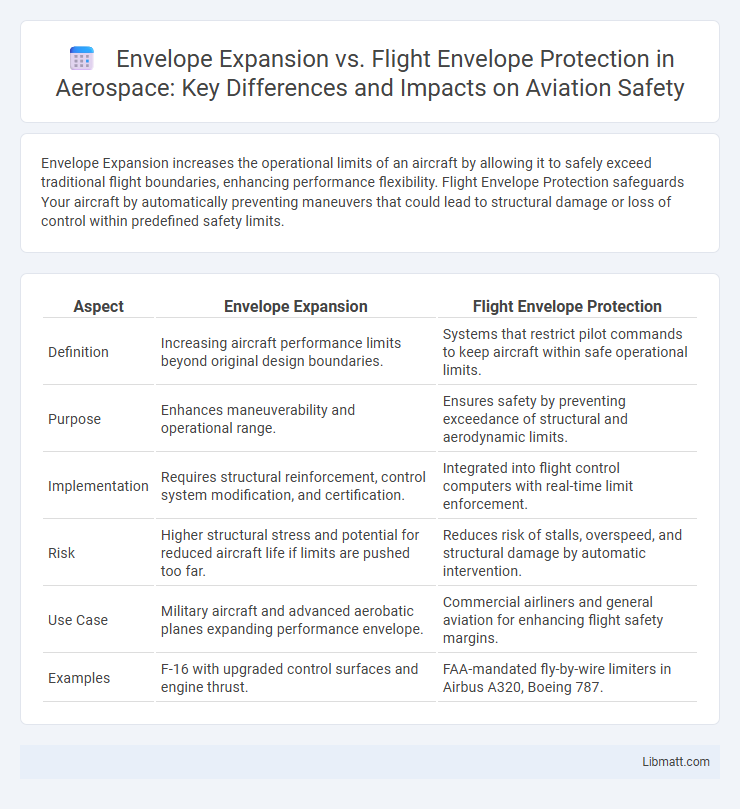Envelope Expansion increases the operational limits of an aircraft by allowing it to safely exceed traditional flight boundaries, enhancing performance flexibility. Flight Envelope Protection safeguards Your aircraft by automatically preventing maneuvers that could lead to structural damage or loss of control within predefined safety limits.
Table of Comparison
| Aspect | Envelope Expansion | Flight Envelope Protection |
|---|---|---|
| Definition | Increasing aircraft performance limits beyond original design boundaries. | Systems that restrict pilot commands to keep aircraft within safe operational limits. |
| Purpose | Enhances maneuverability and operational range. | Ensures safety by preventing exceedance of structural and aerodynamic limits. |
| Implementation | Requires structural reinforcement, control system modification, and certification. | Integrated into flight control computers with real-time limit enforcement. |
| Risk | Higher structural stress and potential for reduced aircraft life if limits are pushed too far. | Reduces risk of stalls, overspeed, and structural damage by automatic intervention. |
| Use Case | Military aircraft and advanced aerobatic planes expanding performance envelope. | Commercial airliners and general aviation for enhancing flight safety margins. |
| Examples | F-16 with upgraded control surfaces and engine thrust. | FAA-mandated fly-by-wire limiters in Airbus A320, Boeing 787. |
Understanding Envelope Expansion
Envelope Expansion allows pilots to deliberately extend an aircraft's operational limits beyond the standard flight envelope, enhancing maneuverability during critical situations. This system requires precise pilot input and situational awareness to safely push beyond normal boundaries without triggering automatic protection limits. Understanding Envelope Expansion helps you optimize aircraft performance while balancing safety and control in demanding flight conditions.
What Is Flight Envelope Protection?
Flight envelope protection is an advanced avionics system designed to prevent an aircraft from exceeding its safe operational limits, including speed, altitude, and maneuvering parameters. It continuously monitors flight conditions and automatically intervenes by adjusting control inputs to maintain the aircraft within its structural and aerodynamic boundaries. This technology enhances pilot safety by reducing the risk of stalls, overstressing the airframe, and loss of control during critical flight phases.
Key Differences Between Envelope Expansion and Flight Envelope Protection
Envelope expansion increases an aircraft's operational limits beyond its original design to enhance performance, while flight envelope protection restricts controls to keep the aircraft within safe parameters. Envelope expansion is typically achieved through aerodynamic modifications or software updates, whereas flight envelope protection uses sensors and automated control systems to prevent exceeding critical speed, angle of attack, or load factor. The key difference lies in expansion enabling greater maneuverability versus protection prioritizing safety by preventing entry into hazardous flight conditions.
Historical Development of Envelope Expansion Techniques
Envelope expansion techniques evolved from early military aviation experiments in the 1940s, where pilots pushed aircraft beyond prescribed flight envelopes to enhance maneuverability in combat. Advancements in fly-by-wire systems during the 1970s and 1980s enabled precise control inputs that safely extended operational boundaries without compromising structural integrity. Modern envelope expansion leverages real-time sensor data and adaptive control laws to dynamically adjust aircraft limits while maintaining pilot command authority.
Evolution of Flight Envelope Protection Systems
Flight envelope protection systems have evolved from basic mechanical limits to sophisticated digital controls integrating multiple sensors, enhancing aircraft safety and performance. Envelope expansion technologies push these limits further by allowing pilots to safely extend operational boundaries under controlled conditions, enabling better maneuverability and efficiency. Understanding how your aircraft's flight envelope protection adapts helps ensure maximum safety while exploring expanded flight capabilities.
Safety Implications: Expansion vs Protection
Envelope Expansion allows pilots to operate aircraft beyond traditional limits, increasing performance flexibility but raising the risk of structural stress and potential system failures under extreme conditions. Flight Envelope Protection systems actively prevent pilots from exceeding safe operational boundaries by automatically limiting control inputs, reducing the likelihood of stalls, overspeeds, and loss of control incidents. The safety implications favor Flight Envelope Protection as it enhances operational safety by maintaining aircraft integrity and preventing pilot-induced errors, whereas Envelope Expansion increases risk by exposing the airframe to conditions beyond certified limits.
Technological Innovations Enabling Flight Envelope Management
Technological innovations such as advanced flight control systems, real-time sensor integration, and adaptive algorithms have revolutionized flight envelope management by enabling precise Envelope Expansion and Flight Envelope Protection. These systems use data from multiple sensors to predict and prevent aircraft from exceeding operational limits, enhancing safety and performance. Your aircraft benefits from these technologies through improved maneuverability, reduced pilot workload, and enhanced response to dynamic flight conditions.
Applications in Modern Aircraft Design
Envelope expansion technologies increase the operational limits of an aircraft by enhancing structural strength and aerodynamic performance, allowing safer flight at higher speeds, altitudes, and maneuvering loads. Flight envelope protection systems use advanced sensors and flight control software to automatically prevent pilots from exceeding safe operational boundaries, enhancing safety and reducing the risk of structural damage or loss of control. Modern aircraft designs integrate both approaches to maximize performance and safety, with envelope expansion enabling broader flight capabilities and flight envelope protection ensuring those capabilities are utilized within safe parameters.
Challenges and Limitations of Each Approach
Envelope expansion increases aircraft performance limits but can introduce risks such as increased structural stress and reduced pilot situational awareness, potentially leading to unsafe maneuvers. Flight envelope protection uses automated systems to prevent pilots from exceeding safe boundaries, yet may limit pilot control flexibility and adaptability in unexpected scenarios. You must balance these approaches carefully to maintain safety without overly restricting aircraft capabilities or pilot decision-making.
Future Trends in Flight Envelope Technologies
Future trends in flight envelope technologies emphasize the integration of advanced sensors and AI-driven systems to enhance both envelope expansion and flight envelope protection. Adaptive control algorithms are being developed to dynamically adjust flight parameters, allowing extended operational capabilities without compromising safety limits. Emerging innovations focus on seamlessly blending envelope expansion with protection mechanisms to optimize aircraft performance and reduce pilot workload.
Envelope Expansion vs Flight Envelope Protection Infographic

 libmatt.com
libmatt.com